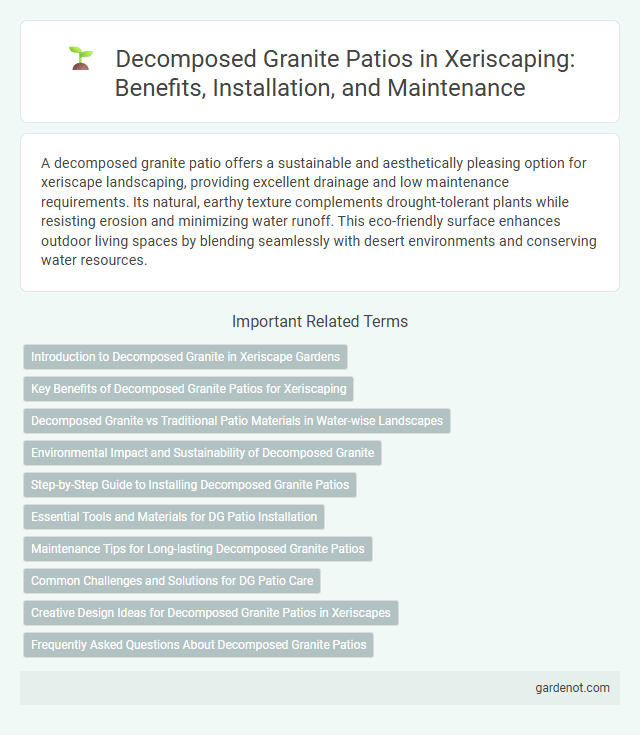A decomposed granite patio offers a sustainable and aesthetically pleasing option for xeriscape landscaping, providing excellent drainage and low maintenance requirements. Its natural, earthy texture complements drought-tolerant plants while resisting erosion and minimizing water runoff. This eco-friendly surface enhances outdoor living spaces by blending seamlessly with desert environments and conserving water resources.
Introduction to Decomposed Granite in Xeriscape Gardens
Decomposed granite is a popular choice for xeriscape gardens due to its excellent drainage properties and natural appearance. This material consists of weathered granite fragments that create a stable, permeable surface ideal for patios, pathways, and garden beds. Using decomposed granite in xeriscaping conserves water by reducing runoff and supporting native plant growth in arid climates.
Key Benefits of Decomposed Granite Patios for Xeriscaping
Decomposed granite patios offer exceptional water conservation benefits, making them ideal for xeriscaping by reducing runoff and promoting natural infiltration. Their permeable surface minimizes soil erosion and heat absorption, enhancing outdoor comfort and sustainability. Low maintenance and cost-effective installation further support drought-tolerant landscaping goals, creating an eco-friendly and aesthetically pleasing space.
Decomposed Granite vs Traditional Patio Materials in Water-wise Landscapes
Decomposed granite patios offer superior water efficiency compared to traditional patio materials like concrete or pavers by allowing better water infiltration and reducing runoff. This porous surface supports sustainable landscaping by minimizing water waste, making it ideal for xeriscape designs emphasizing drought tolerance. Additionally, decomposed granite requires less maintenance and lowers heat retention, contributing to cooler outdoor spaces in arid climates.
Environmental Impact and Sustainability of Decomposed Granite
Decomposed granite patios significantly reduce environmental impact by minimizing water usage and promoting natural drainage, aligning perfectly with xeriscaping principles. This permeable material limits runoff, supports groundwater recharge, and decreases the urban heat island effect compared to traditional concrete or asphalt surfaces. Utilizing decomposed granite enhances sustainability by being a locally sourced, low-energy material that requires minimal maintenance and reduces reliance on chemical treatments.
Step-by-Step Guide to Installing Decomposed Granite Patios
Installing a decomposed granite patio begins with selecting the appropriate area, ensuring proper drainage by grading the site, and removing existing grass or debris. Next, compact the soil before laying a weed barrier fabric to prevent growth, then spread a 3-4 inch layer of decomposed granite evenly using a rake for smoothness. Finally, compact the granite with a plate compactor, moisten to aid settling, and apply a stabilizer if desired for enhanced durability and erosion resistance.
Essential Tools and Materials for DG Patio Installation
Essential tools for decomposed granite (DG) patio installation include a plate compactor, landscape fabric, and a rake to ensure proper layering and compaction. Materials such as reclaimed decomposed granite, coarse gravel for the base, and stabilizer additives enhance durability and reduce erosion. Measuring tape and a wheelbarrow also streamline the process, enabling precise layout and efficient transportation of materials.
Maintenance Tips for Long-lasting Decomposed Granite Patios
Regularly rake decomposed granite patios to prevent compaction and maintain proper drainage, which helps preserve their texture and durability. Applying a stabilizer or polymer binder every one to two years enhances the surface's resistance to erosion and dust. Address drainage issues promptly to avoid water pooling, which can weaken the granite base and reduce the patio's longevity.
Common Challenges and Solutions for DG Patio Care
Decomposed granite (DG) patios often face challenges such as erosion, weed growth, and compaction, which can compromise their durability and appearance. Regular maintenance including reapplying a stabilizer or binder helps reduce erosion and dust, while periodic raking and topping up the DG material prevent compaction and maintain a smooth surface. Incorporating weed barriers beneath the DG and using herbicides as needed effectively control weed growth, ensuring a low-maintenance and long-lasting xeriscape patio.
Creative Design Ideas for Decomposed Granite Patios in Xeriscapes
Decomposed granite patios in xeriscapes offer versatile, low-maintenance design options that blend natural textures with sustainable landscaping principles. Integrating curved pathways, geometric patterns, and contrasting plant beds enhances visual appeal while promoting water conservation. Incorporate native drought-tolerant plants and strategically placed boulders to create focal points that complement the earthy tones of decomposed granite surfaces.
Frequently Asked Questions About Decomposed Granite Patios
Decomposed granite patios provide a cost-effective, low-maintenance option ideal for xeriscaping due to their excellent drainage and natural appearance. Common questions include how to prevent erosion, the best installation techniques, and suitable sealants to extend durability in arid climates. Proper compaction and periodic reapplication of stabilizers ensure long-lasting integrity while maintaining water efficiency.
Decomposed granite patio Infographic

 gardenot.com
gardenot.com